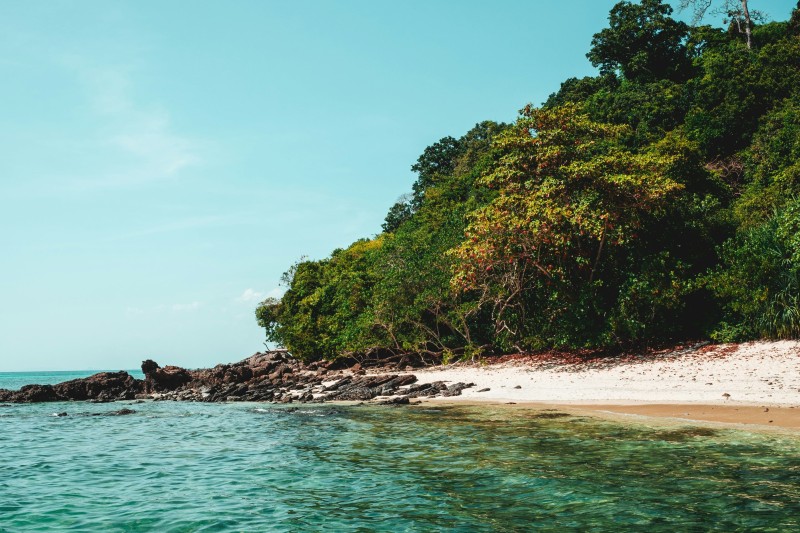The district was established in December 1901. It consists of
four island groups : Mu Ko Lanta (170 km), Mu Ko Klang (162 km),Mu Ko Rok (3.5 km), and Mu Ko Ngai (3.6 km). Other island groups are
smaller, like Mu Ko Haa.The origin of the name
is unclear, but it may originate from the Javanese word "lantas", meaning a type
of grill for fish. The name of the island was officially changed to
"Lanta"
The district, approximately 70 km from Krabi town, consists
of three major islands. The first, Ko Klang, is separated from the mainland by a small
river (klong) and road bridge, and is often mistakenly thought of as part of
mainland Krabi Province. Of the two remaining larger islands, the
largest, more populated Ko Lanta Yai (commonly known as simply "Ko
Lanta") and the smaller Ko Lanta Noi, together with 50 other smaller islands make up the 52-island Mu
Ko Lanta National Park. The largest island (Ko Lanta Yai) has nine white sandy beaches
running down the entire west coast, forests, and tropical jungle. The geography
of the island is typically mangroves; coral rimmed beaches; and tree-covered
hills. A popular tourist destination, the islands are known for their long,
sandy beaches and scuba diving.Ko Lanta Yai and Ko Lanta Noi are connected with a bridge . The bridge has led to many
tourist projects on the undeveloped island.
Attractions
·
ActivitieKo Lanta National Park – Covering a total area of 135 square
kilometres is in Amphoe Ko Lanta and consists of many islands. The two major
islands are Ko Lanta Yai (เกาะลันตาใหญ่) and Ko Lanta Noi (เกาะลันตาน้อย)
·
Lanta
Old Town – Culturally
diverse with Chinese merchants, original Thai fishing families, and an ancient
Sea Gypsy community. Many years ago, Ko Lanta's Old Town acted as the port and
commercial center for the island and provided a safe harbor for Arabic and
Chinese trading vessels sailing between the larger ports of Phuket, Penang, and
Singapore.
·
Khao
Mai Kaew Caves – These caves,
in the centre of the island, house impressive stalactites and stalagmites. Some
of the caves are just very large and one contains a pool.
·
Sea
Gypsy Village – Known to the
Thais as "chao-le", sea gypsies have occupied the area for hundreds
of years, settling along the coast in stilted houses erected in the sea. They
are unique in that they mix very little with the general population, speak
their own language, and have their very own traditional beliefs and rituals.
Activities
►Scuba Diving The diving surrounding Ko Lanta are
considered by many to be among some of the best the country has to offer. There
is a variety of fringing reefs, marine life, caves, rocks, and islets.
Hin Daeng and Hin Muang near Ko Lanta are perhaps the best dive sites in
Thailand (ranking in the world's top ten) with more than 200 hard corals and
108 reef fish catalogued in a study underway, but thousands more organisms
abound. Hin Daeng has the steepest and deepest in the whole of the country with
beautiful marine life. Hin Muang next door is completely underwater and it is
covered with delicate violet coral. The sites also have one of the world's
highest incidences of manta ray sightings, with fairly frequent whale sharks.
►Snorkeling Snorkeling can be done around the three
islands, Ko Haa, Ko Bida, and Ko Rok, all accessible from Ko Lanta via
speedboat or longtail boat.
►Fishing Fishers usually catch the likes of
marlin, sailfish barracuda, red snapper, and tuna during a longtail boat trip
having a choice of either day fishing or night fishing.
►Kayaking The east side of Ko Lanta with its rich
mangroves is the most suitable for kayaking in peace and quiet while admiring
the natural surroundings. Kayaking is also the best way to explore caves.
Kayaking can also be done in mangrove swamps at Baan Tungyeepeng and Ko
Talabaeng, the limestone cliff near Ko Lanta.
►Hiking Ko Lanta's forests with excellent flora
and fauna are suitable for hiking. Elephant rides are usually arranged to take
visitors to the top of the hill in Ko Lanta National Park.
►Thai boxing There is one small boxing stadium on the
island which hosts regular events. It also holds training camps, which are
popular among tourists who wish to learn Thai boxing.
►Thai cooking Thai cooking courses on Ko Lanta offer
foreign tourists the chance to learn to cook their favourite dishes such as tom
yum kung, sweet green curry, and chicken with cashew nuts.
►Spa Traditional Thai massage is aimed at
enhancing not only one's physical and emotional state but also to allow one to
grow spiritually. There are many spas on this island. Massage on the beach is
also possible.
